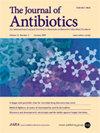Blue benzoquinone from scorpion venom shows bactericidal activity against drug-resistant strains of the priority pathogen Acinetobacter baumannii
IF 2.1
4区 医学
Q3 BIOTECHNOLOGY & APPLIED MICROBIOLOGY
引用次数: 0
Abstract
Antibiotic-resistant bacteria pose a significant global health threat, particularly pathogens resistant to last-resort antibiotics, such as those listed as priority pathogens by the World Health Organization. Addressing this challenge requires the development of novel antimicrobial agents. Previously, we identified a blue 1,4-benzoquinone isolated from the venom of the Mexican scorpion Diplocentrus melici as a potent antimicrobial compound effective against Staphylococcus aureus and Mycobacterium tuberculosis. Moreover, we devised a cost-effective synthetic route for its production. In this study, we demonstrate that the blue benzoquinone exhibits antibacterial activity against additional pathogens, including the priority pathogen Acinetobacter baumannii. Notably, the compound effectively killed clinical strains of A. baumannii resistant to multiple antibiotics, including carbapenem and colistin. Furthermore, A. baumannii did not develop resistance to the benzoquinone even after multiple growth cycles under sub-inhibitory concentrations, unlike the tested antibiotics. These findings underscore the potential of this blue benzoquinone as a lead compound for the development of a new class of antibiotics targeting multidrug-resistant bacteria.

从蝎子毒液中提取的蓝色苯醌对优先病原菌鲍曼不动杆菌的耐药菌株具有杀菌活性。
耐抗生素细菌对全球健康构成重大威胁,特别是对最后使用的抗生素(如世界卫生组织列为重点病原体的抗生素)具有耐药性的病原体。应对这一挑战需要开发新的抗微生物药物。此前,我们从墨西哥蝎子Diplocentrus melici的毒液中分离出一种蓝色1,4-苯醌,作为一种有效的抗金黄色葡萄球菌和结核分枝杆菌的抗菌化合物。此外,我们还设计了一种具有成本效益的合成路线。在这项研究中,我们证明了蓝色苯醌对其他病原体具有抗菌活性,包括优先病原体鲍曼不动杆菌。值得注意的是,该化合物有效地杀死了对多种抗生素(包括碳青霉烯类和粘菌素)耐药的鲍曼不动杆菌临床菌株。此外,与所测试的抗生素不同,鲍曼不动杆菌在亚抑制浓度下即使经过多个生长周期也不会对苯醌产生耐药性。这些发现强调了这种蓝色苯醌作为开发一类针对多重耐药细菌的新型抗生素的先导化合物的潜力。
本文章由计算机程序翻译,如有差异,请以英文原文为准。
求助全文
约1分钟内获得全文
求助全文
来源期刊

Journal of Antibiotics
医学-免疫学
CiteScore
6.60
自引率
3.00%
发文量
87
审稿时长
1 months
期刊介绍:
The Journal of Antibiotics seeks to promote research on antibiotics and related types of biologically active substances and publishes Articles, Review Articles, Brief Communication, Correspondence and other specially commissioned reports. The Journal of Antibiotics accepts papers on biochemical, chemical, microbiological and pharmacological studies. However, studies regarding human therapy do not fall under the journal’s scope. Contributions regarding recently discovered antibiotics and biologically active microbial products are particularly encouraged. Topics of particular interest within the journal''s scope include, but are not limited to, those listed below:
Discovery of new antibiotics and related types of biologically active substances
Production, isolation, characterization, structural elucidation, chemical synthesis and derivatization, biological activities, mechanisms of action, and structure-activity relationships of antibiotics and related types of biologically active substances
Biosynthesis, bioconversion, taxonomy and genetic studies on producing microorganisms, as well as improvement of production of antibiotics and related types of biologically active substances
Novel physical, chemical, biochemical, microbiological or pharmacological methods for detection, assay, determination, structural elucidation and evaluation of antibiotics and related types of biologically active substances
Newly found properties, mechanisms of action and resistance-development of antibiotics and related types of biologically active substances.
 求助内容:
求助内容: 应助结果提醒方式:
应助结果提醒方式:


